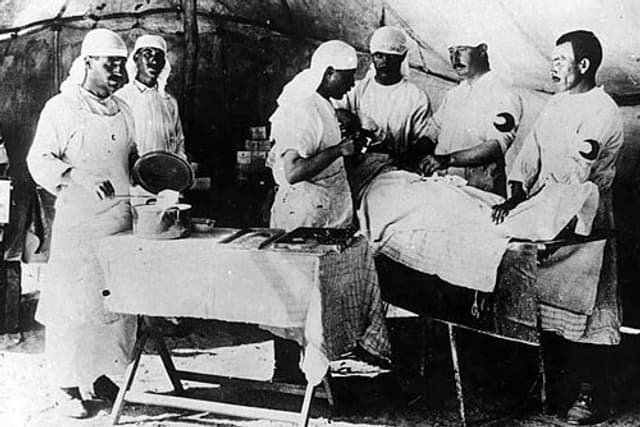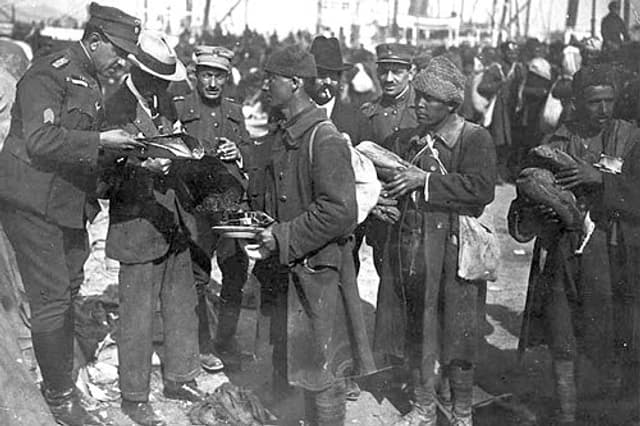International Committee of the Red Cross: Helping victims of the Turkish-Greek conflict
- Exhibited by
- ICRC
- Added
- June 16, 2022
- Medium of Communication
- Press, events, public collections
- Target Audience
- All donors
- Type of Charity
- Humanitarian aid
- Country of Origin
- International
- Date of first appearance
- 1923
SOFII’s view
This is a great addition to the SOFII history project. While we are a little sad that the fine detail of the fundraising effort is vague, it is clear that people felt galvanised by the refugee crisis in Greece and Turkey and mobilised what they could a mere four years after the end of a devastating war.
Summary / objectives
The International Committee of the Red Cross (ICRC) needed to raised money to come to the aid of people displaced by the Turkish-Greek conflict of 1919-1922, in particular the thousands of civilians held captive by the respective authorities in each country.
Creator / originator
International Committee of the Red Cross
Background
At the end of the First World War, Greece felt that, with Turkey apparently much weakened, the situation was favourable for an extension of its sovereignty in Asia Minor. In May 1919, a Greek expeditionary force disembarked in Smyrna (modern-day Izmir) and set out to conquer the hinterland, penetrating the heart of Anatolia (the Asian part of Turkey). However, Turkish forces resisted, regaining the upper hand in August 1922 and retaking Smyrna on 9 September.
A resolution was signed at Mudanya, in Anatolia, on 11 October 1922. A conference of all the powers interested in restoring peace to the Near East met in Lausanne, Switzerland, in January 1923. The Turkish-Greek agreement that resulted on 30 January provided for the repatriation of all civilian prisoners on both sides regardless of number, as well all the Turkish prisoners of war and an equal number of Greek prisoners of war. The remainder of the Greek prisoners of war were to be repatriated after signing the peace treaty, which took place on 24 July 1923.
The Turkish-Greek conflict caused hundreds of thousands of persons of Greek origin to flee Asia Minor, while thousands of people of Turkish origin fled Thrace (a region that today is split between Bulgaria, Greece and Turkey) for Turkey.
In January and February 1922 and again at the beginning of 1923, ICRC delegates visited prisoners of war and civilian detainees on both sides. In Greece, the ICRC visited all the detention camps. Most of the detainees were women, children and elderly men. Representatives of the Hellenic Red Cross made regular visits to those places and distributed aid.
At the end of its round of visits, the ICRC called for the elderly men, women, children and breadwinners to be repatriated first. These repatriations began shortly after the ICRC mission.
In Turkey, an ICRC delegate visited the Greek prisoners, who, unlike the Turks imprisoned in Greece, were practically all military personnel. As these persons had no personal effects, they were provided with clothing by the Turkish Red Crescent. At the end of his visit, the ICRC delegate distributed aid in cash and kind.
Special characteristics
The plight of Turkish refugees arriving from Greek-controlled Thrace into Turkey, and of Anatolian Greeks fleeing into Greece required the mobilisation of multiple Red Cross and Red Crescent societies under the guidance of the International Committee of the Red Cross. The national organisations of the Red Cross and Red Crescent raised money and donated it to the ICRC. The ICRC then mobilised to come to the aid of refugees, prisoners of war and oppressed minorities in both countries (it should however be noted that requests by the ICRC to both the Greek and Turkish governments to assist the plights of Muslims in Greece and Christians in Turkey were refused).
The money was raised using the standard fundraising techniques of the time, as far as can be ascertained by the ICRC historian we spoke to, with appeals in the press in countries where the Red Cross and Red Crescent operated, public collections, events such as concerts or conferences and letters to major donors. While records no longer exist of actual campaigns, the British historian Misha Glenny, in his book The Balkans, asserts that most of the money raised came from individual donors.
Results
According to Misha Glenny, in his aforementioned book, The Balkans, the total raised from individual donations exceeded US$2 million. However, it is unclear where that figure comes from. ICRC historian Daniel Palmieri, gives a more modest assessment:
‘In 1923, the ICRC received a little more than 50,000 Swiss francs from these National Societies. The ICRC also occasionally received money from private donors.
Concerning the aid to Greek and Turkish (but also Bulgarian) refugees, the sums obtained were much less than the 2 million you indicate. The appeal for donations was launched by the ICRC and the League of Red Cross Societies (in a joint commission) and was not so successful. In its activity report for 1923 to 1925, the ICRC indicates that it paid in 1923 the Greek Red Cross and the Turkish Red Crescent the sum of 7,777.25 Swiss francs. In addition, 12,725 Swiss francs were sent to the sanitary services in Asia Minor. In 1922, the ICRC had paid 12,802.80 Swiss francs to these two national societies, as well as 24,940 Swiss francs in relief (according to the activity report for 1921 to 1923). In 1922, the ICRC had received 119, 244.90 Swiss francs from the National Red Cross or Red Crescent Societies.’
Even if the number is lower than Glenny’s assertion, it is important to remember that the world was reeling from the First World War in 1922, so, in addition to adjustments for inflation, the sums raised were remarkable and well worth celebrating. Given the circumstances, the help the ICRC provided to displaced people in Greece and Turkey would have saved thousands of lives.
Editor's note: Of course, if you have more information about the way the money was raised or what the total was, SOFII and the ICRC would love to hear from you.
Influence / impact
With the support of the International Union for Child Welfare, the Hellenic Red Cross and the Turkish Red Crescent, the ICRC undertook a large-scale relief operation to assist the refugees. Even before the agreement to end the war, delegates were dispatched to Greece and Turkey to assess the number of refugees and the nature of their needs.
In Greece, the ICRC delegate arrived on 26 September 1922 and was received by the king and queen. He was informed that some 250,000 refugees of Greek origin had already arrived in the country and that thousands more were expected. In some places, these people were completely destitute. Greek and foreign committees were set up to aid these refugees.
On the other side, thousands of Muslim refugees fled western Thrace into Turkey. On 25 September 1922, an ICRC delegate arrived in Constantinople (today’s Istanbul), where he began arranging for aid to be delivered in Anatolia. He then proceeded to the area and organised distributions.
However, the refugees were so numerous (over two million in all) that the ICRC’s resources proved insufficient. For this reason, the relief operation was taken over by the High Commission for Refugees with the support of the League of Nations.
The Lausanne accord between Greece and Turkey provided for the repatriation of prisoners of war and civilian detainees under the auspices of a commission comprising three representatives of Red Cross societies from States which had remained neutral during the First World War, as well as one Greek and one Turkish representative. Entrusted with the task of naming the members of the commission, the ICRC called on the services of Colonel Wildbolz and Dr Page of the Swiss Red Cross and of Dr Lindsjö of the Swedish Red Cross.
From 19 March to 4 May 1923, the commission directed the repatriation of 4,601 Turkish civilians, 320 Greek civilians, 9,748 Turkish soldiers and 293 officers, and a similar number of Greek officers and men. The remaining 5,000 Greek prisoners of war – visited by the ICRC in June and July 1923 – were repatriated by the commission after the peace treaty was signed. In total, 33,183 prisoners of war and civilian detainees were repatriated.
Although established separately from the ICRC, the commission acted as part of the International Committee, to which it appealed for assistance in conducting its operations when faced with difficulties and to which it reported when it had completed its mandate.
(You can read more about the conflict and the relief operation here)
 View original image
View original image
 View original image
View original image
 View original image
View original image
















